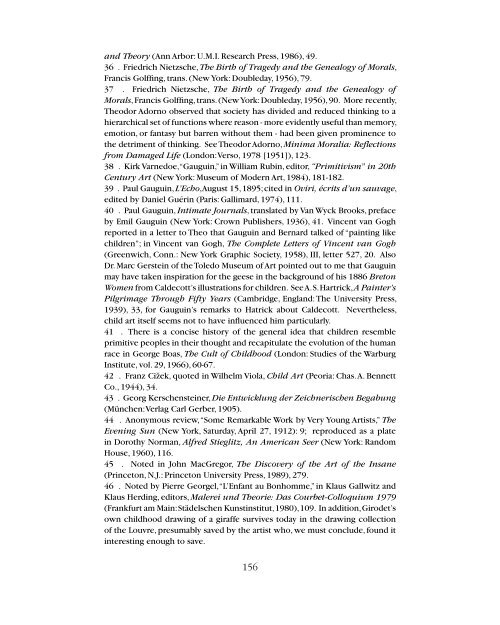Jonathan Fineberg – The Postman Did It – Children’s Art and the Avant-garde
Excerpt from “A Kid Could Do That!”, an extensive publication prepared by Galerie Gmurzynska on the occasion of the large-scale eponymous exhibition project at Art Basel Miami Beach 2014, conceived with Hollywood luminaries Baz Luhrmann and Catherine Martin.
Excerpt from “A Kid Could Do That!”, an extensive publication prepared by Galerie Gmurzynska on the occasion of the large-scale eponymous exhibition project at Art Basel Miami Beach 2014, conceived with Hollywood luminaries Baz Luhrmann and Catherine Martin.
- No tags were found...
You also want an ePaper? Increase the reach of your titles
YUMPU automatically turns print PDFs into web optimized ePapers that Google loves.
<strong>and</strong> Theory (Ann Arbor: U.M.I. Research Press, 1986), 49.<br />
36 . Friedrich Nietzsche, The Birth of Tragedy <strong>and</strong> <strong>the</strong> Genealogy of Morals,<br />
Francis Golffing, trans. (New York: Doubleday, 1956), 79.<br />
37 . Friedrich Nietzsche, The Birth of Tragedy <strong>and</strong> <strong>the</strong> Genealogy of<br />
Morals, Francis Golffing, trans. (New York: Doubleday, 1956), 90. More recently,<br />
Theodor Adorno observed that society has divided <strong>and</strong> reduced thinking to a<br />
hierarchical set of functions where reason - more evidently useful than memory,<br />
emotion, or fantasy but barren without <strong>the</strong>m - had been given prominence to<br />
<strong>the</strong> detriment of thinking. See Theodor Adorno, Minima Moralia: Reflections<br />
from Damaged Life (London: Verso, 1978 [1951]), 123.<br />
38 . Kirk Varnedoe, “Gauguin,” in William Rubin, editor, “Primitivism” in 20th<br />
Century <strong>Art</strong> (New York: Museum of Modern <strong>Art</strong>, 1984), 181-182.<br />
39 . Paul Gauguin, L’Echo, August 15, 1895; cited in Oviri, écrits d’un sauvage,<br />
edited by Daniel Guérin (Paris: Gallimard, 1974), 111.<br />
40 . Paul Gauguin, Intimate Journals, translated by Van Wyck Brooks, preface<br />
by Emil Gauguin (New York: Crown Publishers, 1936), 41. Vincent van Gogh<br />
reported in a letter to Theo that Gauguin <strong>and</strong> Bernard talked of “painting like<br />
children”; in Vincent van Gogh, The Complete Letters of Vincent van Gogh<br />
(Greenwich, Conn.: New York Graphic Society, 1958), III, letter 527, 20. Also<br />
Dr. Marc Gerstein of <strong>the</strong> Toledo Museum of <strong>Art</strong> pointed out to me that Gauguin<br />
may have taken inspiration for <strong>the</strong> geese in <strong>the</strong> background of his 1886 Breton<br />
Women from Caldecott’s illustrations for children. See A. S. Hartrick, A Painter’s<br />
Pilgrimage Through Fifty Years (Cambridge, Engl<strong>and</strong>: The University Press,<br />
1939), 33, for Gauguin’s remarks to Hatrick about Caldecott. Never<strong>the</strong>less,<br />
child art itself seems not to have influenced him particularly.<br />
41 . There is a concise history of <strong>the</strong> general idea that children resemble<br />
primitive peoples in <strong>the</strong>ir thought <strong>and</strong> recapitulate <strong>the</strong> evolution of <strong>the</strong> human<br />
race in George Boas, The Cult of Childhood (London: Studies of <strong>the</strong> Warburg<br />
Institute, vol. 29, 1966), 60-67.<br />
42 . Franz Cižek, quoted in Wilhelm Viola, Child <strong>Art</strong> (Peoria: Chas. A. Bennett<br />
Co., 1944), 34.<br />
43 . Georg Kerschensteiner, Die Entwicklung der Zeichnerischen Begabung<br />
(München: Verlag Carl Gerber, 1905).<br />
44 . Anonymous review, “Some Remarkable Work by Very Young <strong>Art</strong>ists,” The<br />
Evening Sun (New York, Saturday, April 27, 1912): 9; reproduced as a plate<br />
in Dorothy Norman, Alfred Stieglitz, An American Seer (New York: R<strong>and</strong>om<br />
House, 1960), 116.<br />
45 . Noted in John MacGregor, The Discovery of <strong>the</strong> <strong>Art</strong> of <strong>the</strong> Insane<br />
(Princeton, N.J.: Princeton University Press, 1989), 279.<br />
46 . Noted by Pierre Georgel, “L’Enfant au Bonhomme,” in Klaus Gallwitz <strong>and</strong><br />
Klaus Herding, editors, Malerei und Theorie: Das Courbet-Colloquium 1979<br />
(Frankfurt am Main: Städelschen Kunstinstitut, 1980), 109. In addition, Girodet’s<br />
own childhood drawing of a giraffe survives today in <strong>the</strong> drawing collection<br />
of <strong>the</strong> Louvre, presumably saved by <strong>the</strong> artist who, we must conclude, found it<br />
interesting enough to save.<br />
156

















